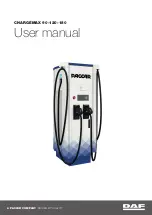
Operating Instructions
6
01583G
RED LIGHT
GREEN LIGHT
FUNCTION
Off
Off
No AC power or no battery
connected
Steady
Steady
Light test when AC connected
Low Glow
Slow Blink
Charging (less than 80%)
Low Glow
Fast Blink
Charging (over 80% charged)
Low Glow
Steady
Normal charge completed
Low Glow
Off
AC power connected, not
charging
Steady
OFF
Undervoltage shutoff,
< 18.0 volts
Slow Blink
OFF
Overvoltage shutoff,
> 33.96 volts
Fast Blink
OFF
Max. timer shutoff, > 16 hours
1.
If the RED and GREEN lights do not illuminate
within three seconds after the AC power is
applied to the charger, it indicates one of the
following:
a.
Charger "POWER" switch is not in "ON"
position.
b.
Charger is not plugged into a live AC outlet.
2.
If both lights go off and stay off three to five (3-5)
seconds after the charger connections are
completed, it indicates one of the following and
the charger is prevented from turning on:
a.
DC plug not connected to the equipment
receptacle.
b.
Fault in equipment wiring. Poor or open
connections in the wiring that connects to
the batteries. Corroded terminals, loose or
worn plugs and receptacles, loose or worn
fuseholders. (Have your dealer repair the
equipment.)
c.
Battery connections in equipment wrong
(reverse polarity).
d.
One or both batteries no longer serviceable
(voltage below 7 volts for a 24 volt system).
3.
If the charger turns off before the batteries are
fully charged, it indicates one of the following:
a.
Charger internal thermal breaker turned the
charger off due to overheating because
charger ventilation openings are blocked.
After the charger has cooled down to a safe
temperature, it will automatically restart. If
the charger repeatedly overheats it may be
malfunctioning.
b.
The AC power was interrupted during
charge.
c.
The DC cord-charging plug accidentally
disconnected during charge.
d.
Fault in equipment wiring. The equipment
charging circuit has high resistance,
corroded or loose connections, loose or
worn charging receptacle, and loose or worn
fuseholders.
4.
A decrease in equipment range where it loses
power earlier and earlier in the day indicates one
of the following:
a.
Use of the equipment before the batteries
have been fully charged and the charger
turns off shortens battery life and hastens
the onset of this reduced daily range.
Battery capacity lost in this manner is
permanent and is not recovered with
additional charge cycles.
b.
Conventional replaceable liquid electrolyte
batteries are being under charged on the gel
cell "BATTERY TYPE" switch setting.
Battery capacity lost in this manner is
permanent and is not recovered with
additional charge cycles.
c.
Severe overcharging occurs when gel cell
(maintenance free) batteries are charged on
the conventional wet lead acid "BATTERY
TYPE" switch setting. Battery capacity lost
in this manner is permanent and occurs very
rapidly. Check with your dealer about
battery replacement.
d.
The battery has been allowed to sulfate.
Charge the battery no less frequently than
once every three days when the equipment
is lightly utilized. Once sulfating is allowed
to take place, it may be partially reduced by
returning, temporarily, to daily charging.
e.
The electrolyte level in conventional liquid
electrolyte lead-acid batteries was allowed
to drop below the top of the battery plates.
Add distilled water to just cover the tops of
the plates immediately upon discovery and
fill to the proper level with distilled water at
the completion of the very next charge cycle.
Battery capacity lost in this manner is
permanent and is not recovered with
additional charge cycles.
f.
This is the normal wear out process for all
types of deep-cycle motive power batteries.
5.
If battery voltage does not exceed 18 volts after
10 minutes of charging, the charger turns off and
the RED light will turn on steady, indicating one
of the following:
a.
Improper batteries used with charger. Must
be a 12 cell, series connected 2.38-2.50
volts per cell battery system.



























